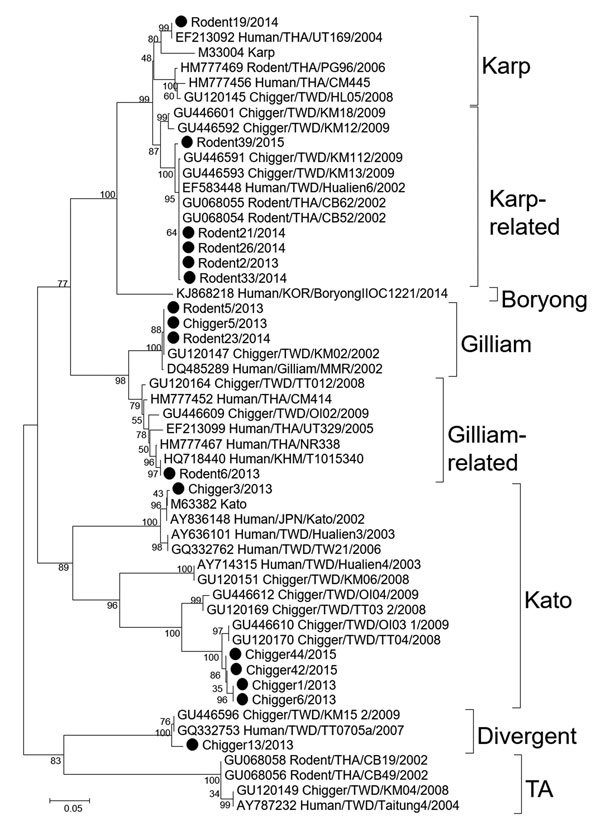Scrub Typhus Outbreak in Chonburi Province, Central Thailand, 2013
Wuttikon Rodkvamtook

, Narupon Kuttasingkee, Piyada Linsuwanon, Yutthapong Sudsawat, Allen L. Richards, Maneerat Somsri, Noppadon Sangjun, Chien-Chung Chao, Silas Davidson, Elizabeth Wanja, and Jariyanart Gaywee
Author affiliations: Royal Thai Army Component—Armed Forces Research Institute of Medical Science, Bangkok, Thailand (W. Rodkvamtook, N. Kuttasingkee, Y. Sudsawat, M. Somsri, N. Sangjun, J. Gaywee); US Army Medical Directorate—Armed Forces Research Institute of Medical Science, Bangkok (P. Linsuwanon, S. Davidson, E. Wanja); Naval Medical Research Center, Silver Spring, Maryland, USA (A.L. Richards, C.-C. Chao)
Main Article
Figure 2

Figure 2. Phylogenetic tree of nucleotide sequences of partial Orientia tsutsugamushi 56-kDa type-specific antigen encoding genes obtained from rodents and chiggers in Chonburi Province, Thailand, 2013 (black circles). Tree was constructed by neighbor-joining on the basis of the Kimura 2-parameter model and maximum-likelihood methods using the general time reversible model. Bootstrapping for 1,000 replications was included in all phylogenetic tree constructions. No difference in tree topology was observed among phylogenetic trees constructed by the 2 methods. Nucleotide sequences of chiggers and rodent tissue samples from Thailand have been deposited in GenBank (accession nos. MF431253–MF431268); GenBank accession numbers are provided for reference sequences. Genotypes are indicated at right. Scale bar indicates nucleotide substitutions per site.
Main Article
Page created: January 17, 2018
Page updated: January 17, 2018
Page reviewed: January 17, 2018
The conclusions, findings, and opinions expressed by authors contributing to this journal do not necessarily reflect the official position of the U.S. Department of Health and Human Services, the Public Health Service, the Centers for Disease Control and Prevention, or the authors' affiliated institutions. Use of trade names is for identification only and does not imply endorsement by any of the groups named above.
